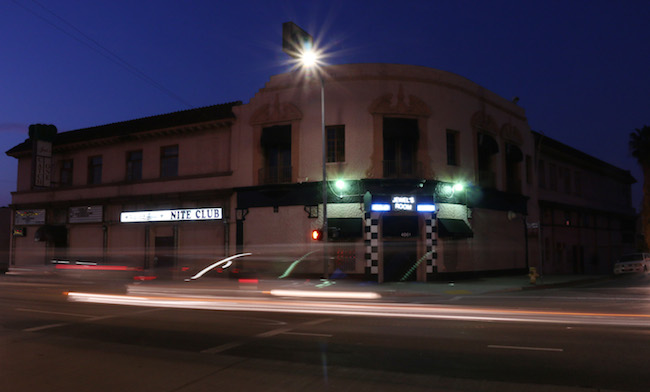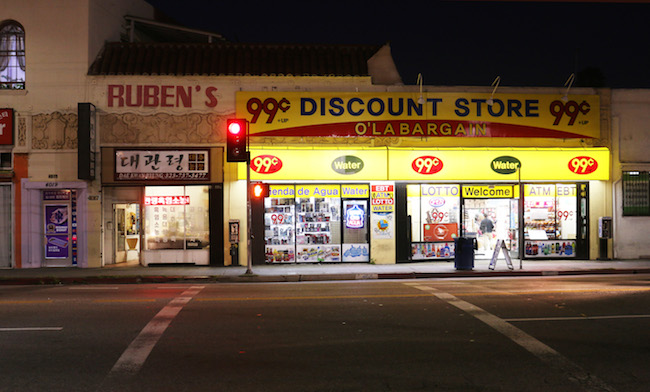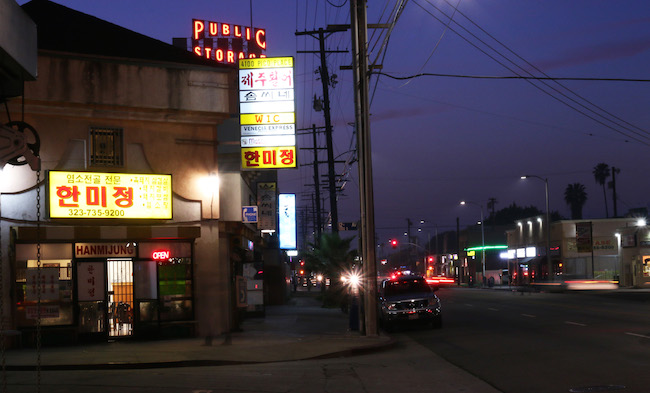I am a transplant to Los Angeles, I’m a person of color, and I live in a rapidly gentrifying neighborhood. Witnessing and doing my best not to accelerate these changes, I’ve spent a lot of time thinking about the history of Los Angeles. The city is often presented as without history, or rather its most validated history is that of Hollywood: the metonym for fantasy, non-reality, and projection. In both critical and popular culture, Los Angeles exists as the nexus of abstract dreaming and escapism—but typically white dreams and white escape. This covers up the actual history and existence of black, brown, Native, and Asian populations. Coming from Virginia, just outside of Washington, DC, where the value of history is embedded in the local culture, I see the myth of Los Angeles’s lack of history as perhaps the most successful act of social erasure in the United States. It’s a real Hollywood job.
Los Angeles clearly functions as a symbol of white dreams and white escape within the contemporary art world as well, as manifested by the recent fairs. The last weekend of January 2015 ended with the New York–based Printed Matter’s third annual Los Angeles Art Book Fair, the second year of Paramount Ranch Art Fair, and Art Los Angeles Contemporary. With a total attendance of 35,000 people, the fair attracted Angelenos and fellow artmongers from across the United States and abroad for wintertime art-frolicking in the sun. There was a controversy involving Printed Matter’s sale of prints using the Black Lives Matter (BLM) slogan on early-admission tickets with none of the proceeds going to that organization, but race is not a usual part of the discussion at L.A. art fairs.
The events of this weekend would not be complete without a huge after-party. On Saturday night, the party for the book fair was at Jewel’s Catch One, a legendary black gay-and-lesbian nightclub in Arlington Heights. This neighborhood lies just north of the 10 Freeway, the border for majority-black neighborhoods forged by white flight in the mid-twentieth century. Higher concentrations of blacks live south of the 10 in neighborhoods like Baldwin Hills, Crenshaw, Jefferson Park, and the cities of Inglewood and Compton. But the ethnic compositions of those neighborhoods have changed since the 1992 riots. From 1990 to 2010 the presence of blacks significantly decreased, as Latino populations increased. My father’s family lives in Compton, the city made famous by ’90s gangster rap. It is not unreasonable to think that even this neighborhood could soon gentrify and return to its 1950s origins, when Compton was an exclusively white neighborhood, guarded from black residents by racial covenants, housing laws, and strict policing.
Jewel’s Catch One was founded in 1972 by the activist and entrepreneur Jewel Thais-Williams, who describes it as a “community center especially for African American Gays, Lesbians, Bis, Tries, and Otherwise.”[1] The club was the first to cross a geographical line that hindered black establishments, and Thais-Williams, as a black, female business owner, was also challenging social boundaries. It was a safe and popular destination during the end of the civil-rights era and throughout the AIDS crisis. Snapshots of the club in its heyday can be found online.
During Thais-Williams’s ownership, celebrities like Chaka Khan, Madonna, Sammy Davis, Jr., Gregory Hines, and Sandra Bernhard, attended the club.[2] Jewel’s Catch One was also involved in community outreach to the underserved, helping recovering alcoholics, addicts, and those with HIV/AIDS. In 2001, Thais-Williams opened the Village Health Foundation next door to the club to continue these efforts.
At the after-party, I felt like a traitor, being in this particular club for the first time while in the company of people so jarringly white that sometimes I forgot I was black. I felt like a fish out of water. At any given art event, I’m used to being one of the only black people in the room, but not while the other black women and men are collecting cover fees at the door, tending the bar, and dancing on the pole. I didn’t know the history of Jewel’s Catch One before hearing about the party, but Los Angeles is full of venues with forgotten political significance. What will happen to the history of this club, just one of the many sites that will be erased by gentrification?
In the fall of 2014, the club was sold. It is now operated by Graeme Flegenheimer’s promotion company, The Church Off York, which grew out of The Church On York, a performing-arts venue in the neighborhood of Highland Park. The company programs experimental and alternative artists for Jewel’s Catch One, and acts will be only as diverse as the general demographics of the music industry; most are white artists who will bring in mostly white crowds. I’m sure the attraction of The Church Off York lineup will eventually make Arlington Heights one of the next neighborhoods to gentrify. Already, young white artists are moving into South Central Los Angeles, which would have been unheard of twenty years ago.
In an interview last year, Thais-Williams stated that she decided to sell the club because “the need [for the club] isn’t there anymore…now the community can go anywhere they want to. And now, even when I come out on a Saturday night, no one’s dancing, no one’s talking. They’re all standing on the edge of the room and all you see is white lights, screens.”[3] I assume she’s referring to smartphones. These days, members of the lesbian-gay-bisexual-transgender-queer-questioning-intersex-ally (LGBTQQIA) community can connect on the Internet, black people have more mobility in the city, and society’s approach to nightlife has simply changed. The Internet plays a large role in socioeconomic shifts; in Los Angeles specifically, it contributes to the dynamism of art spaces and, with them, the forces of gentrification.
Los Angeles is considered by many to be the sexiest city in America, and to artists especially, because it is a cheaper, warmer alternative to New York. With the aid of Instagram, events like the aforementioned art fairs germinate the fantasy of art’s Hollywoodland at an exponential rate. As artists, like me, continue to move to L.A., more historical buildings will be bought up, forcing out the black and brown people who will no longer be able to afford to live there, and along with them their histories.
Thais-Williams’s observation makes me feel a sense of loss, both for the club as it was in the past and for a kind of social space I will probably never experience in my lifetime. History is everywhere in Los Angeles, but you have to search for it; not every important person gets a star on the Walk of Fame. Jewel’s Catch One, as it once was, no longer exists. In a city where usually only the acts of white men are remembered, it would be unfortunate for Jewel Thais-Williams’s social work and activism to be lost in time.
——
[1] “Jewel Thais-Williams,” LinkedIn profile, accessed February 1, 2015, https://www.linkedin.com/in/jewelthaiswilliams/en.
[2] “Jewel Thais-Williams,” LinkedIn profile.
[3] Dianne Lawrence, “Jewel’s Catch One Nightclub Closing,” The Neighborhood News Online, October 17, 2014, https://theneighborhoodnewsonline.net/local-people/featured-resident/1001-jewel-s-catch-one-nightclub-closing.






